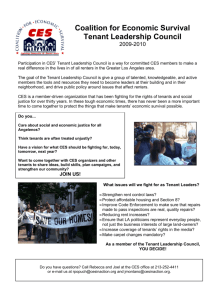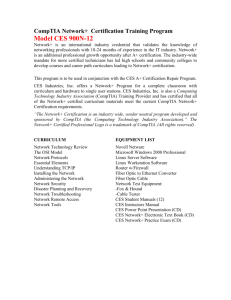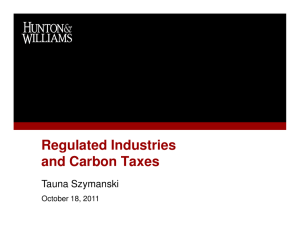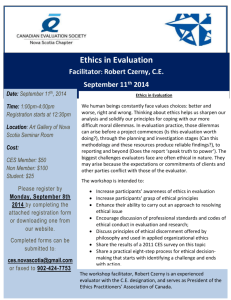A F CES: I W
advertisement
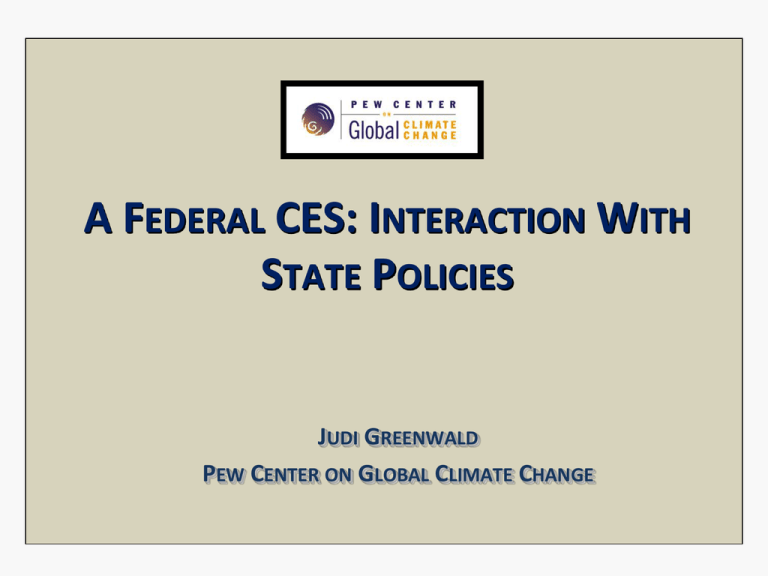
A FEDERAL CES: INTERACTION WITH STATE POLICIES JUDI GREENWALD PEW CENTER ON GLOBAL CLIMATE CHANGE OVERVIEW 1. State of play of state-level clean energy policies 2. Options for treating state RPS and CES programs under a federal CES, and implications of these options 3. State/federal issues related to energy efficiency treatment under a federal CES 4. Stringency issues STATE OF PLAY States are implementing a variety of clean energy policies Net metering, public benefit funds, green pricing, RPS, EERS Several states have “CES-like” policies Ohio, Michigan, West Virginia, Pennsylvania How state-level RPSs and CESs are treated within a Federal CES has implications for the effectiveness and cost-effectiveness of a national-level program, as well as for states wishing to promote their own clean energy sources. STATE RPS AND AEPS RPS: 27 States AEPS: 4 States Goal: 8 States Source: www.pewclimate.org STATE EERS •Elect: 15 States •Elect and Gas: 11 States •Pending: 1 State •Voluntary: 2 States Source: www.pewclimate.org OPTIONS FOR TREATMENT OF STATE PROGRAMS UNDER A FEDERAL CES 1. Pre-empt the state programs with a federal CES; 2. Keep state and federal programs distinct and separate; 3. Integrate state and federal programs (make state RECs and federal CECs fungible); or 4. Allow ambitious state programs to ensure additional aggregate, national clean energy generation PREEMPTION Two arguments for preemption: Excessive compliance burden on utilities Inefficiency – departure from least-cost clean power mix However: Compliance unlikely to prove onerous for utilities Costs borne by ambitious states will be selfimposed—presumably for in-state benefits (e.g., clean energy jobs) States oppose preemption. Why pick this fight? DISTINCT FEDERAL AND STATE PROGRAMS Qualified clean energy generators can earn both state and federal credits, and utilities face separate state and federal compliance obligations. Approach taken in recent federal CES and RES proposals. State programs will simply change how clean energy generation is distributed among the states. Benefit of being relatively simple and avoiding a fight with states. MAKE STATE/FED RECS FUNGIBLE State RECs count toward federal CES (without double-counting). Heterogeneity of state programs would create challenges. Federal policymakers would forgo their ability to define qualified clean energy themselves. Likely to be administratively complex. Potential for gaming by states seeking to avoid CES compliance obligation. ALLOW STATES TO GO BEYOND FEDS Allow for ambitious states to exceed federal CES without simply lessening requirement for other states. One option is to require state RECs and federal CECs be bundled and sold, transferred, and retired together. More thought is needed on this option. ENERGY EFFICIENCY ISSUES Measuring electricity savings may prove administratively difficult and contentious, particularly since states already measure electricity savings from energy efficiency differently. Awarding credits for “business-as-usual” EE savings lessens the impact of CES on clean energy deployment. Historically, certain states and utilities have been more aggressive in pursuing energy efficiency than others. STRINGENCY ISSUES Stringency depends on both the target % and the qualifying resources. Obama’s goal: 80% of U.S. electricity by 2035 Includes renewables, nuclear, fossil fuels with CCS, and CC natural gas (partial credit). Recent Congressional RPS proposals: 15-20% by 2020 Includes non-hydro renewables, incremental hydro Recent Senate CES proposals: 30-35% U.S. electricity by 2035 Include non-hydro renewables, incremental hydro, coal with CCS, incremental nuclear. State RPSs: range from 12% by 2011 to 33% by 2020 Includes wide range of renewable resources and carve outs. State AEPS’s: range from 10% by 2015 to 25% by 2025 Includes: ranges from “90% must come from renewables” to “large hydro, waste coal, coal IGCC, natural gas.” FOR MORE INFORMATION Judi Greenwald Vice President, Innovative Solutions PEW CENTER ON GLOBAL CLIMATE CHANGE greenwaldj@pewclimate.org www.pewclimate.org




